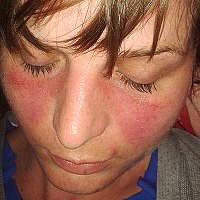
Photo from wikipedia
BackgroundAlthough trough levels of immunosuppressive drugs are largely used to monitor immunosuppressive therapy after solid organ transplantation, there is still no established tool that allows for a validated assessment of… Click to show full abstract
BackgroundAlthough trough levels of immunosuppressive drugs are largely used to monitor immunosuppressive therapy after solid organ transplantation, there is still no established tool that allows for a validated assessment of functional degree of immunosuppression or the identification of clinically relevant over- or under-immunosuppression, depending on graft homeostasis. Reliable non-invasive markers to predict biopsy proven acute rejection (BPAR) do not exist. Literature data suggest that longitudinal measurements of immune markers might be predictive of BPAR, but data in children are scarce. We therefore propose an observational prospective cohort study focusing on immune monitoring in children after liver transplantation. We aim to describe immune function in a cohort of children before and during the first year after liver transplantation and plan to investigate how the immune function profile is associated with clinical and laboratory findings.MethodsIn an international multicenter prospective approach, children with end-stage liver disease who undergo liver transplantation are enrolled to the study and receive extensive immune monitoring before and at 1, 2, 3, 4 weeks and 3, 6, 12 months after transplantation, and whenever a clinically indicated liver biopsy is scheduled. Blood samples are analyzed for immune cell numbers and circulating levels of cytokines, chemokines and factors of angiogenesis reflecting immune cell activation. Statistical analysis will focus on the identification of trajectorial patterns of immune reactivity predictive for systemic non-inflammatory states, infectious complications or BPAR using joint modelling approaches.DiscussionThe ChilSFree study will help to understand the immune response after pLTx in different states of infection or rejection. It may provide insight into response mechanisms eventually facilitating immune tolerance towards the graft. Our analysis may yield an applicable immune panel for non-invasive early detection of acute cellular rejection, with the prospect of individually tailoring immunosuppressive therapy. The international collaborative set-up of this study allows for an appropriate sample size which is otherwise difficult to achieve in the field of pediatric liver transplantation.
Journal Title: BMC Gastroenterology
Year Published: 2018
Link to full text (if available)
Share on Social Media: Sign Up to like & get
recommendations!